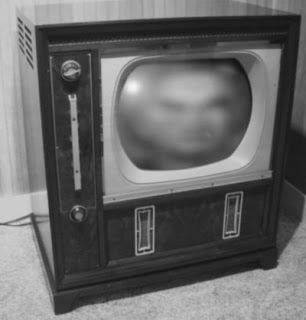Stories of souls trapped or lost in television’s nowhere land permeated the folklore of the Sputnik Era. In 1953 the NY Times carried an article about a Long Island family with a TV set inhabited by the ghost of a mysterious woman. Jerome Travers and his 3 children reported seeing the woman during Ding Dong School.The Travers family was besieged by reporters, but the image never reappeared
In the 1960’s a Wisconsin woman claimed to have seen a couple arguing on a balcony and the call letters of a defunct radio station on her television screen. The vision was followed by a desperate cry for help. Rosella Rose was not the first person to see the KLEE station card almost twelve year after it was abandoned, and when news of her sighting appeared in the papers it reinforced public perception that television was a netherworld where even the most fleeting earthly message could be trapped.

Reports of electronic transmissions between the real and the spirit world in the early days of television were generated by public anxiety surrounding the new technology. For a viewing public unfamiliar with ideas like electromagnetic waves, static, and cathode ray tubes, a host of suspicions arose including the belief that a television set was capable of transporting individuals to another dimension, holding them captive in some sort of electronic limbo, and if conditions were right, becoming remote viewers for surveillance.

These
paranoia made rich fodder for a host of science fiction plots on popular television series like
The Outer Limits and
The Twilight Zone. Early
television reception was also full of electronic
deficiencies like
double images, phantom transmissions, and sound distortions that gave rise to a host of sightings. Scholars have linked these sightings to quickly changing social realities that fueled public distrust. The cultural implications of ghost sightings at the dawn of the television age have been written about at length by social historians in books like
Haunted Media: Electronic Presence From Telegraph to Television and
The Revolution Wasn’t Televised. Public reaction today to a
ghost in the machine is quite different as evidenced by the reaction of the giggling group in the
YOUTube video showing above. Due to constant exposure to the video stream our reactions are now mitigated by both experience with the technology and our sophistication with the meaning and limitations of media.


